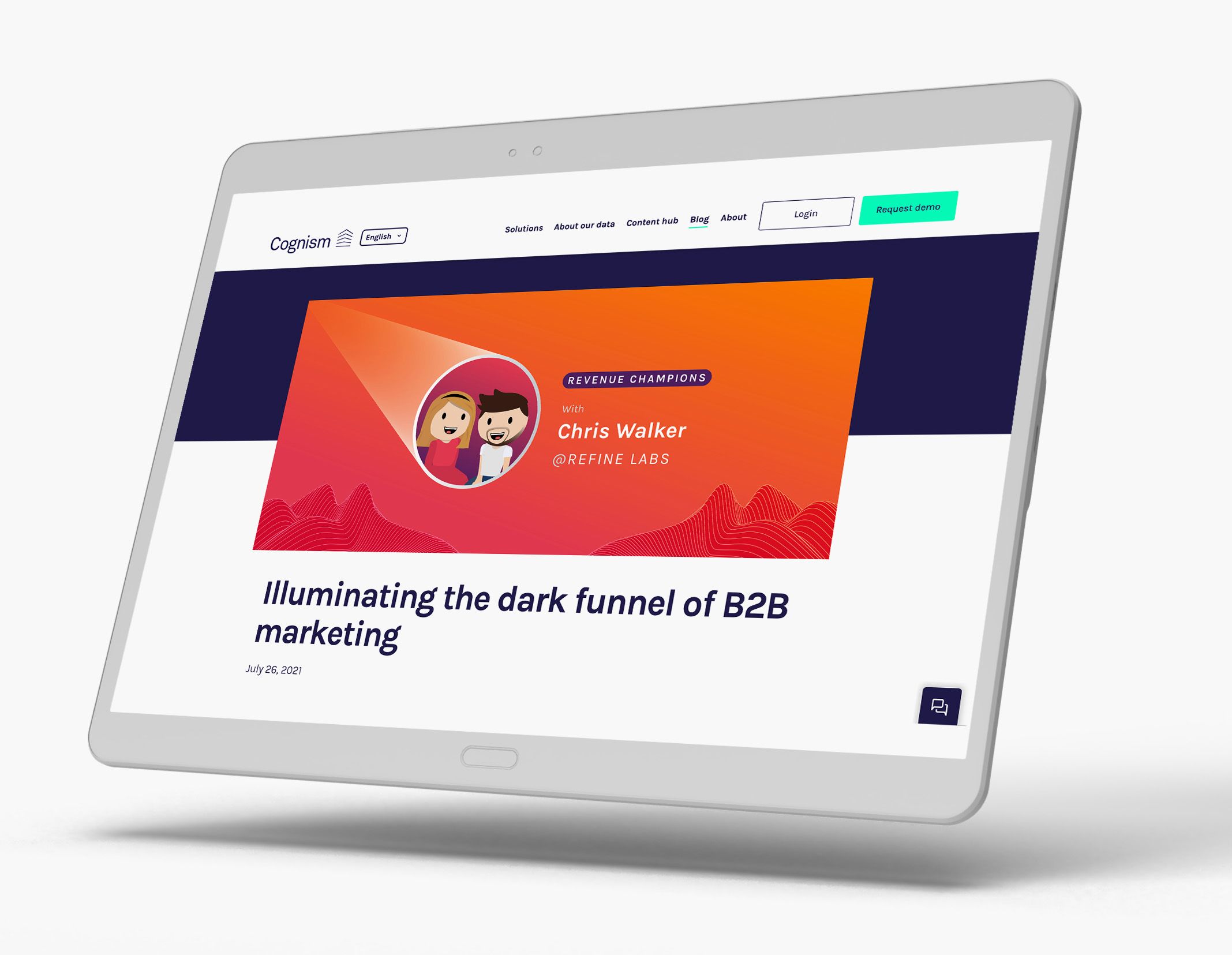How to measure content success
By Kiera Abbamonte

Think of the last piece of content you put out into the world: was it successful?
Gauging content success isn’t always straightforward, and you may not have an answer to that question at all. Heck, you may not even have a clear picture of what “success” actually means for your content strategy.
But finding a way to meaningfully measure content success is crucial, whether you’re working in communications, journalism, or traditional content marketing.
As we cover in this guide, measuring your content:
- Makes it possible to competently report on your content program to higher-ups.
- Helps you double-down on what works and improve content over time.
- Shows you what doesn’t work, so you can optimise your spend.
- Enables you to prove content marketing ROI, set Key Performance Indicators (KPIs), and make the case for additional resources.
Now, we get it. Measuring content performance isn’t easy, but it can be done—by having a clear content marketing strategy and purpose for what you create, along with an understanding of what you can measure, how to do it, and what those numbers mean for your content.
Additional resource: check out our full guide to content marketing metrics →
What do the BBC, Tripadvisor, and Penguin have in common?
They craft stunning, interactive web content with Shorthand. And so can you! Create your first story for free — no code or web design skills required.
Sign up now.
Set the right incentives

Before we dive into the specifics of how to measure content success, let's address the elephant in the room. Content marketers on the web — including those working in B2B marketing — have a reputation for producing poor-quality content, written primarily to game search engines or harvest email addresses.
This reputation didn't come out of thin air. A lot of content marketing is written for this purpose. But this isn't because content marketers are poor writers, or lack scruples.
It's because the metrics they report on incentivise bad content.
It's hard to square this circle. Your managers and executive team are always going to want a clear, data-driven narrative about the return on investment from your work.
And there are a range of content marketing metrics to measure. These include organic search rankings, bounce rates, conversion rates, average time on page, engagement metrics, backlinks acquired, click-through rates, and old-fashioned website traffic.
There are also a range of marketing qualified leads to report on, including webinar signups, email newsletter signups, downloads of gated content, and other form completions.
The problem is, all of these important metrics can be gamed. For example, it's entirely possible for a content marketer to grow organic traffic ten-fold, without having any significant impact on the business. And anyone can harvest emails from a landing page to a gated white paper — even if the ebook is poorly produced and none of these emails actually converts to new business.
With the wrong incentives, content creators can produce poor-quality content — content that actively harms the reputation of their business — even as their reports to management are showing massive success.
Looking for more content inspiration?
Join 15,000 other content creators and get the best immersive content on the web in your inbox. One email a week.
The challenges of content attribution

In content marketer dream world, everyone who takes your desired action does so via the easily-tracked UTM link on that content. To measure content success, then, all you have to do is pull up Google Analytics and look at your UTM parameters.
But that isn’t the world we live in. Today’s content consumers live complex, interwoven digital lives. They follow meandering—and sometimes lengthy—digital journeys and make purchasing decisions based on untrackable things like IRL recommendations from friends.
There are, of course, ways to track audiences across the web and build impressive attribution models to give content credit, even back to the first click. But there’s always a limit.
And while technology continues to open up new possibilities for content attribution, truly robust attribution modelling can be really expensive, and it doesn’t always work 100 percent. Plus, user privacy and tracking regulations (like GDPR in the EU) limit the data you can collect. These are already causing tech giants to move toward a cookie-less world in the near future.
All that means: attributing leads and sales back to content is hard. It inherently requires a certain level of comfort with uncertainty.
That fundamental truth is a big part of why a growing number of marketers are investing in “dark funnel marketing”—using the kinds of marketing tactics that can’t be quantitatively measured by attribution software.
Dark funnel marketing represents a growing willingness to invest in content marketing channels — such as social media platforms liked LinkedIn and closed communities — that cannot be measured by attribution or analytics software.
Still, most content creators need to report on their content one way or another—and acknowledging what can’t be measured is a key part of that.
Traps to avoid when measuring content marketing success

Before we dive into how to measure content performance and success, we need to talk about how not to do it. As you develop your strategy for gauging content success, here are some of the biggest pitfalls you’ll need to avoid.
Not reporting on your content program at all
It’s easy to give up and avoid reporting on your content at all—but that won’t help you drive business impact or lobby for the resources you need.
Ignoring—or not knowing—your business strategy
Content exists to further business objectives, so if you don’t keep those in mind, your measurements aren’t worth much.
Defaulting to vanity metrics
Metrics like bounce rate, publishing cadence, search features (and traffic, to some extent) don’t tell you anything about how your content moves the needle on the business side.
Ignoring brand reputation
There are always ways to improve performance numbers, but you can’t lose sight of how you position the brand to your audience. It isn't worth sullying your name to win higher traffic.
9 ways to measure content success

Much of what’s been written about setting content marketing goals measuring content focuses on metrics—and there are a lot of different ones you can track. But the key to meaningfully gauging performance is to track content success in ways that matter for you—because success depends on your overall objective.
The metrics you choose will depend on the type of content you produce, the purpose behind it, and the broader business objectives your content needs to help further. Measuring the success of content designed to boost brand awareness is fundamentally different from measuring content built for lead generation, for example.
So instead of an exhaustive list of metrics you must track, we’re highlighting 9 different ways you can track your content marketing efforts—and you can choose the ones that make sense for you.
Business growth and success
At the end of the day, we create content to further broader business goals and objectives. That’s why measuring the impact your content has on North Star metrics like revenue and churn is critical. It answers the fundamental question: is content contributing to the success of the business?
If your content demonstrably brings in more revenue, reduces churn, helps existing customers grow and upgrade, etc., then it’s successful.
Organic traffic
Organic traffic is one of the most popular ways marketers measure content success, and for good reason. It’s easy to measure and report on with the help of Google Analytics and tools like Ahrefs and SEMRush, and improving your position in the SERP with better SEO (search engine optimization) is relatively straightforward.
There’s definitely some value in measuring it. After all, all else being equal, more organic traffic means better ROI on your content.
That said, it’s important not to get tunnel vision about traffic, as it's entirely possible for much — if not most — of your organic traffic to come from outside of your target audience. There’s often a substantial disconnect between traffic and things like leads, signups, and other business results. So it’s important to ensure traffic isn’t your only gauge for success.
Trials
If you’re producing content for a software company or another product that involves a free trial, this can be a valuable way to measure success.
At the end of the day, your content likely can’t convert trial signups into paying customers all on its own. You need a great product, an intuitive onboarding flow, well-executed marketing automation, talented salespeople, and a capable support team to secure that conversion.
By measuring trials from content—using UTM links, for example, or more advanced attribution modelling tools—you can get a better sense of how your content propels customers into the funnel.
Signups
For companies that don’t offer a trial, signups are the next closest thing. Whether they see a blog post and immediately sign up or read a few pieces of content over a matter of months before doing so, those conversions are impacted by content.
You can track signups from content using a tool like Google Analytics—by setting up goals and conversion tracking (more on how you can do this later!)
Education
Not all content is transactional. Sometimes, your content’s main purpose is just to educate people. Knowledge base content, for example, is built to help existing customers succeed—so measuring signups from that content doesn’t make much sense.
While education can seem like a murky thing to measure, better educated leads and customers show up in a number of metrics. For example:
- When leads are more educated about your product and what it can do, the sales process is faster.
- When existing customers are empowered to fully adopt the product and get more value from it, churn goes down.
- And when new customers are familiar with the company already, onboarding is quicker and time to value improves.
Community building and development
Converting new signups or educating customers isn’t the goal of every content piece. If your primary goal is to build a community around your brand, metrics tied to that community are the best gauge of your content’s success.
Community building could be measured in terms of newsletter subscribers, social media followers, or even broader metrics like brand sentiment.
Qualitative feedback
Many of the top ways to measure content success lean on quantitative data: numbers. While hard numbers make it easy to get an objective view of your content and to track changes in performance over time, qualitative data has its place, too.
After all, time on page can tell you how long someone spends on your article, but it can’t tell you why. Actual qualitative feedback from your audience adds another level of depth to your measurement—a level that can help you better understand why successful content resonates, so you can reverse engineer more of it.
Social sharing
Most of the metrics we’ve mentioned focus on content consumption and the action it spurs. But great content can also turn your audience into promoters when they share it across social media.
That’s why measuring social shares—particularly across platforms your brand prioritizes—is key. You can use social media monitoring tools like Hootsuite, Sprout Social, or Agorapulse to track shares.
Impact on the world
The last goal of content we’ll mention: impact. Some content is designed to create a particular outcome in the world. Raising awareness on global issues, for example, like this article from Doctors Without Borders.
This type of content can be measured in a ton of different ways. In the example above, Doctors Without Borders may measure donations received or the number of people who apply to work with the organisation. They may even measure success more broadly as improvements in the region the article discusses.
How to report on content success

Reporting on content is difficult. There are countless vanity metrics, and proving the influence of content A on outcome Z can be tricky. Nonetheless, every content team needs to report on what they do—it’s a crucial aspect of internal marketing and securing the resources you need to build great content.
To that end, here are a few great resources to help you report effectively on content performance:
- Superpath offers an online course on reporting for content marketers. The course covers all the basics you’ll need to know, plus in-depth case studies with prominent marketers, sample reports, and suggestions for further reading.
- If you need to get your reporting set up quickly, this template from Databox is a great starting point. The report includes key metrics like top pages for goal completions, exit pages, and user-level page views over time. Plus, it’s completely customizable.
- For a more advanced way to measure and report on content attribution, content marketing agency Grow & Convert shares an in-depth look at how they approach attribution modeling using the Model Comparison Tool in Google Analytics.
Up next: The Craft's complete guide to content marketing metrics →





